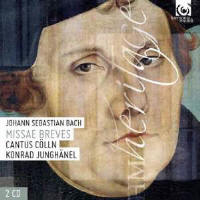Texte paru dans: / Appeared in: |
|
|
Outil de traduction |
|
|
|
|
|
Reviewer: George
Chien Bach is known to have written six Missae breves (or “short” Masses—that is, settings of the first two elements of the Latin ordinary, the Kyrie and the Gloria). One has been lost, one was expanded into the Mass in B-Minor, and the other four are the ones recorded here. These four Missae have common structures: a choral Kyrie followed by a five-part Gloria consisting of two choruses flanking three arias. Because at least 20 (and presumably all) of their combined 24 movements were derived from earlier works there has been a tendency to regard these Missae much like stepchildren with a shadowy parentage. The illogic of such an assessment should have been obvious from the start, since most of the B-Minor Mass (and of the Christmas Oratorio) is parodied from previously existing works. In fact, some scholars now believe that many of the source works for the B-Minor Mass were themselves parodies of even earlier precursors. One begins to wonder whether any original music by Bach still exists!
More recently we have come to appreciate both the importance of parody in Bach’s creative process and the extraordinary skill that the techniques of parody entail. As to why Bach felt compelled to transform one set of compositions into another, it has been speculated that since the church cantatas (not to mention those secular cantatas that preceded them) were of limited use—once a year at best—the Missae allowed Bach to make some of his finest work suitable for multiple occasions. Far from being Bach’s embarrassing creative stepchildren, these so-called “Lutheran” Masses can actually be viewed as highlights in the Bach legacy. Whether in fact they were ever performed in Leipzig is another subject for speculation.
By including them in the final volume of his cantata series, Ton Koopman focused new attention on the Missae. Hard on the heels of that release is this splendid two-disc set by Konrad Junghänel and Cantus Cölln. Cantus Cölln appears here as a double quartet with a relatively generous orchestral component (strings: 5-4-2-2-1). Some choral movements are divided into ripieno and concertino segments, the former sung two-to-a-part and latter by soloists, a most effective solution. The concertinists are not identified, nor are the soloists in the arias, but the singing throughout is fine, as is Junghänel’s admirable direction. Harmonia Mundi’s recording is first-rate. Incidentally, curious listeners will find a list of the sources of the parodied music in the booklet.
The aforementioned Koopman volume (No. 22) featuring the Missae is well recommended, but Philippe Herreweghe’s versions, originally released on two separate Virgin CDs, have long claimed the gold standard. Recently reissued in a four-disc box with six cantatas and the Sanctus, BWV 238, they still do, but Junghänel’s new readings constitute a highly desirable and most worthy contender. | |
|
Sélectionnez votre pays et votre devise en
accédant au site |
|
|
|
|
|
|
|
|
Cliquez l'un ou l'autre
bouton pour découvrir bien d'autres critiques de CD |
|




